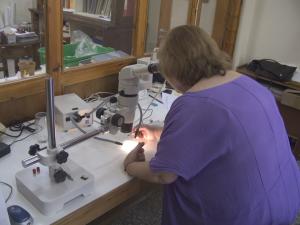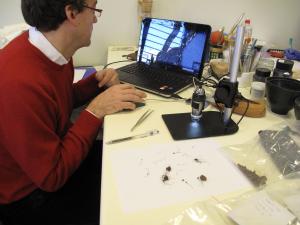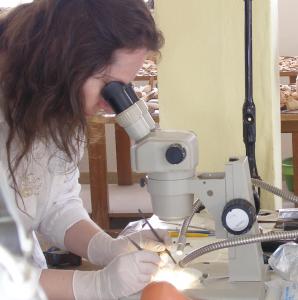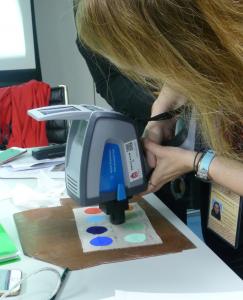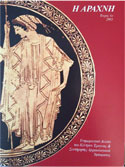Scientific analyses
Geometric amphora fabric NAM 2007.JPG
Stereoscope study of an archaeological textile. Photo S. Spantidaki.
The technique chosen could be invasive or non-invasive and destructive or non-destructive. Invasive are the techniques that necessitate the removal of a sample, whereas non-invasive are the techniques that can generally be applied in-situ. Destructive techniques are those where the sample is destroyed during analysis, whereas non-destructive describes the ones where the sample remains intact and can be further investigated by other techniques. Even techniques considered to be non-destructive by some, such as infrared spectroscopy and scanning electron microscopy, may be destructive in the context of the analysis of excavated textiles, when specimen preparation vitiates its further investigation, e.g. pressure in case of ATR-FTIR, or coating the fibres for scanning electron microscopy analysis with older microscope models. The decision on the type of technique should be based on the existing legislation and professional ethics together with an evaluation of the importance of acquiring the information, e.g. as compared to sacrificing the sample.
Analysis can either be qualitative or quantitative. Qualitative analysis provides information on the type of substances/elements present, whereas, quantitative analysis provides additional information on the amount of substances/elements present. Accurate quantification generally requires larger amounts of sample with replicate analyses, which stresses the importance of the application of truly non-destructive methods to cultural heritage material.
Numerous different instrumental analytical methods have been used for the examination of excavated textiles. They can be divided into five main categories according to the type of information they provide. There are techniques used for:
1) the morphological analysis of textiles and textile fibres, such as X-radiography, CT scanning, 3D scanning, stereomicroscopy, optical microscopy, and scanning electron microscopy (SEM);
2) material identification of textile fibres, such as energy dispersive spectrometry (SEM-EDS), X-ray diffraction (XRD), X-ray Fluorescence (XRF), staining tests (using a stereomicroscope to aid interpretation of the results), Fourier transform infrared microspectroscopy (FTIR), Raman spectroscopy, High Performance Liquid Chromatography (HPLC), and Mass Spectrometry (MS);
3) more detailed material characterisation of fibres and constituent material, such as DNA analysis.
4) dating, such as radiocarbon dating with Accelerator Mass Spectrometry (14C AMS); and
5) provenance, such as strontium isotope analysis (87Sr/86Sr).

